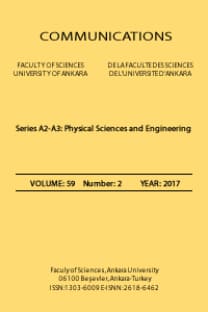OPERATION TESTS of the 260 MHz 1500 W SOLID STATE RF AMPLIFIER at TARLA FACILITY
Radiofrequency (RF), solid state amplifier, accelerator, bunch length, phase stability, high power, operation test
___
Aksoy, A., Karslı, O. and Yavas, O., The Turkish accelerator complex IR FEL project, Infrared Phys. Technol., 51/5 (2008) 378-81.Aksoy, A. and Karsli, O. (Eds.), The technical design report of Turkish Accelerator and Radiation Laboratory in Ankara, Technical Report (Ankara University, 2015).
Aksoy, A., Karsli, O., Aydin, A., Kaya, C., Ketenoglu, B., Ketenoglu, D. and Yavas, O., Current status of Turkish Accelerator and Radiation Laboratory in Ankara: the TARLA facility, Can. J. Phys., 96/7 (2018) 837-42.
Karsli, O., Aksoy, A., Kaya, C., Koc, B., Dogan, M., Elcim, O.F. and Bozdogan, M., High power RF operations studies at TARLA facility, Can. J. Phys., Accepted: https://doi.org/10.1139/cjp-2018-0778.
Wangler, T.P., RF Linear accelerators, John Wiley & Sons, 2008.
Karsli, O., Yavas, O. and Dogan, M., Design of L Band 20 kW High Power Solid State Amplifier for TARLA/TAC Project, Известия высших учебных заведений. Физика., 55/10-3 (2012) 154-9.
Karsli, O. and Yavas, O., A design study on high power RF system for the TARLA facility of TAC, Nucl. Instrum. Methods Phys. Res. A, 693 (2012) 215-9.
Wang, F., Liu, K., Feng, L., Lin, L., Zhang, B., Hao, J. and Quan, S., Using a 1.3 GHz 20 kW Solid State Amplifier as RF Power Supply for DC-SRF Photo-injector, 6th Workshop on ERL, New York, USA 2015.
Dillon, S., Schach, C. and Nobel, B., Design of a high speed pulsed 324 MHz solid-state amplifier for use in a beam chopper, IPAC2012, Louisiana, USA, (2012) 2242-4.
Frenzel, L.E., RF power for industrial applications, Pearson Prentice Hall 2004.
SigmaPhi Accelerator Technologies, https://www.sigmaphi.fr/en/produits/ampli-ficateurs-radiofrequence, Accessed: 2019-03-20.
National Instruments, http://www.ni.com/en-tr/shop/labview/labview-details.html, Accessed: 22.03.2019.
Wurlich, A., CERN Accelerator School, CERN-94-01, 1994.
Wiedemann, H., Particle accelerator physics, (Vol. 314), Springer, Berlin, 2007.
Chao, A.W., Handbook of Accelerator Physics and Engineering, 2nd Printing, World Scientific Publishing Co. Pte. Ltd., pp.256, 1998.
Pozar, D. M., Microwave engineering, 4th Edition, John Wiley & Sons, 174 Chapter 4, 2011.
MathWorks, https://www.mathworks.com/products/matlab.html, Accessed: 22.03. 2019.
Akre, R., Temperature Stability of RF Components, (2005). http://slac. stanford.edu/ grp/lcls/controls/global/subsystems/llrf/26sep2005Review/Temperature%20Stability%20of%20RF%20Components%20Apr%2005.pdf Accessed: 13.04.2019.
Akre, R., Emma, P. and Krejcik, P., Measurements on SLAC LINAC RF system for LCLS Operation
PACS2001, Proceedings of the 2001 Particle Accelerator Conference (Cat. No. 01CH37268), 2 (2001) 1453-1455.
Decker, F.J., Akre, R., Byrne, M., Farkas, Z.D., Jarvis, H., Jobe, K., Koontz, R., Mitchell, M., Pennacchi, R., Ross, M. and Smith, H., Effects of temperature variation on the SLC LINAC RF system, IEEE Proceedings of Particle Accelerator Conference, 3 (1995) 1821-1823.
MAX IV Detailed Design Report, https://www.maxiv.lu.se/accelerators-beamlines/accelerators/accelerator-documentation/max-iv-ddr Accessed: 13.04. 2019.
Suelzle, L.R., RF amplitude and phase stabilization for a superconducting linear accelerator by feedback stabilization techniques, High Energy Physics Lab, (1968), https://www.bnl.gov/magnets/staff/gupta/Summer1968/0067.pdf Accessed: 22.03. 2019.
- ISSN: 1303-6009
- Yayın Aralığı: Yılda 2 Sayı
- Başlangıç: 2019
- Yayıncı: Ankara Üniversitesi
PREPROCESSING STEPS IN fMRI: SMOOTHING
Hacer DAŞGIN, Ali YAMAN, Yılmaz AKDİ
ROBUST REFRACTIVE INDEX FIBER SENSOR BASED ON TWO UP-TAPERS PLACED IN DOWN-TAPER
MAGNETOCALORIC EFFECT AROUND CURIE TEMPERATURE IN Ni50-x CuxMn38Sn12B3 SHAPE MEMORY RIBBONS
OPERATION TESTS of the 260 MHz 1500 W SOLID STATE RF AMPLIFIER at TARLA FACILITY
